anth g6085

dust
michael fitzpatrick (columbia university)
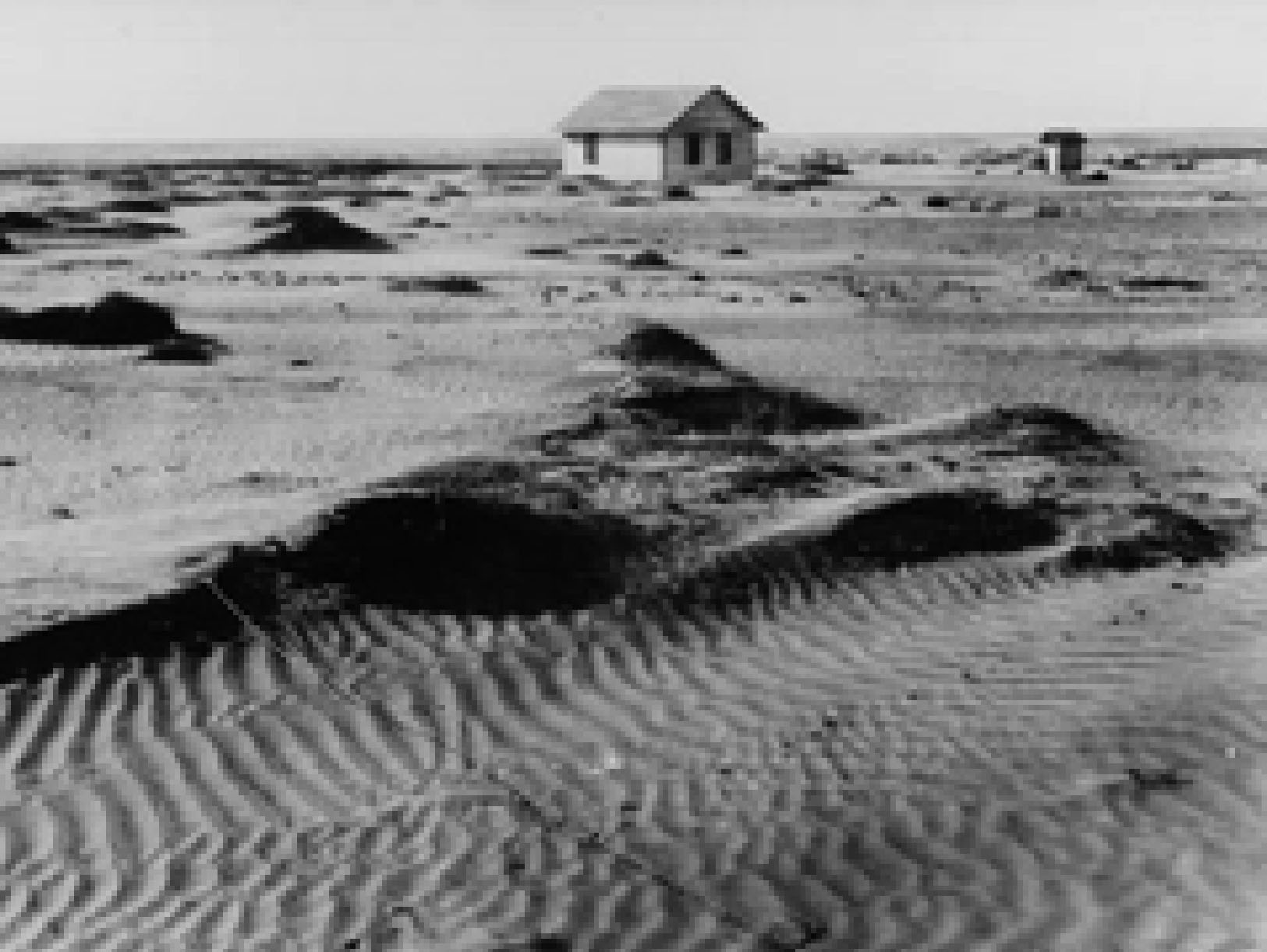
....
Bill Brown writes, “We begin to confront the thingness of objects when they stop working for us: when the drill breaks, when the car stalls, when the windows get filthy…” (Brown 4), when the object ceases to be referenced by its production or display. He continues, “The story of objects asserting themselves as things, then, is the story of a changed relation to the human subject and thus the story of how the thing really names less an object than a particular subject-object relation” (Brown 4). So, in Brown’s terms, the thing as thing, bridges the dichotomy between subject and object. We can see in the filthy window the relation between the window and those who look through it because its changed appearance thrusts it into a different relationship with the viewer. In this sense the thing is not a subject or an object, but a part of a relationship between things. In other words, we should look to things to inform and question what we would normally see as relationships between subjects and objects. It is the purpose of this presentation to question the subject/object dichotomy by using the material example of dust, specifically with respect to the phenomenon of dust storms during the Depression in the central plains. The problem is how does the questioning of dust as mere object illuminate the human and the social and what might we learn with respect to the Dust Bowl that could be ignored without such a study?
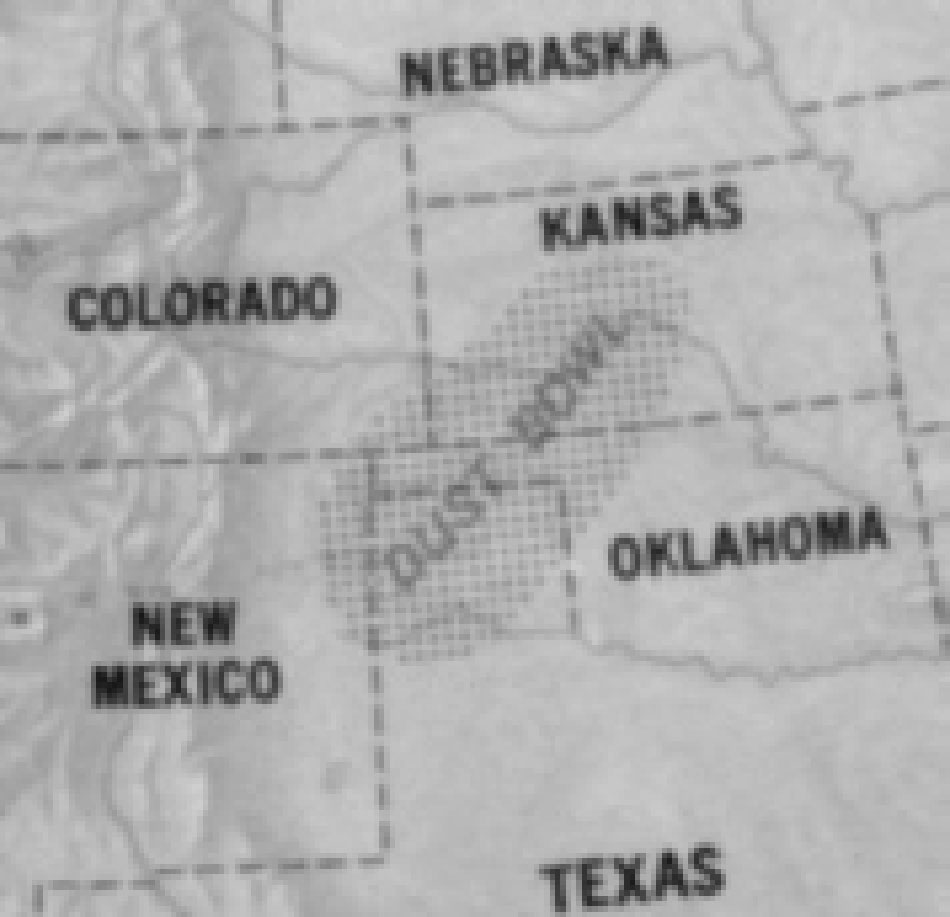 |
||||
| To begin, the Dust Bowl was an area of the Southern Plains of the United States named for the large frequency of dust storms that occurred during the drought and depression of the 1930’s. The area is generally considered to be the southwest corner of Kansas, the Oklahoma panhandle, the northern Texas panhandle, and the adjoining eastern counties of New Mexico and Colorado. While the drought covered much of the central plains, from Canada to Mexico, the Dust Bowl area was especially hard hit by the dust storms. | ||||
All structures in the Dust Bowl were vulnerable to the dust. Indeed, “When the dust fell, it penetrated everything: hair, nose, throat, kitchen, bedroom, well” (Egan 5). The house, the body, and as a result, what is implicated by those things, such as conceptions of home and identity, were likewise penetrated. To mitigate the effects of the dust, “Families put wet towels beneath their doors and covered their windows with bed sheets fresh-dampened nightly” (Egan 7). The wet towels would hold the dust so that it wouldn’t scatter about, but the dust still got everywhere. A family living in an affected community, “…watched the dust seep through the thinnest cracks in the walls of their rental house, spread over the china, into the bedroom, onto the sheets” (Egan 136). Even, “One man’s ceiling collapsed from the weight of dust” (Wooster 23) of his house. These houses and the way in which they were lived in tell us about the inhabitants. The struggle against the never-ending dust storms and when inhabitants choose to leave or became negligent about sweeping dust again and again are a part of how these people dwelled in the place called the Dust Bowl. These relationships with the world of materials helps describe the context in which people live. The dust didn’t just sit there. For the people who are affected by the storms, it lived and breathed. They are subsumed by dust quite literally.
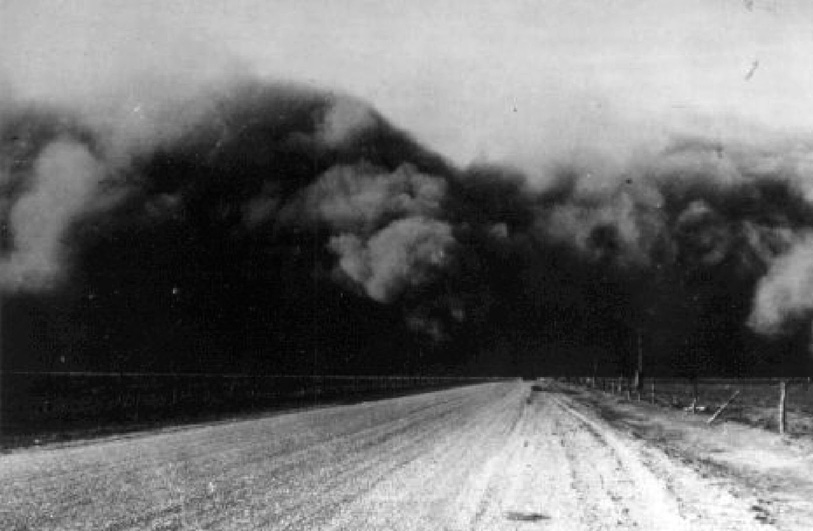
..
In the Dust Bowl as everywhere, “…landscape is anchored in human life, not something to look at but to live in, and to live in socially” (Cosgrove 35). A Garden City woman describes her experience:
“All we could do about it was just sit in our dusty chairs, gaze at each other through the fog that filled the room and watch that fog settle slowly and silently, covering everything – including ourselves – in a thick, brownish gray blanket. When we opened the door swirling whirlwinds of soil beat against us unmercifully…The door and windows were all shut tightly, yet those tiny particles seemed to seep through the very walls. It got into cupboards and closets; our faces were as dirty as if we had rolled in the dirt; our hair was gray and stiff and we ground dirt between our teeth” (Wooster 17).
Tim Ingold writes, “…forms of things are not imposed from without upon an inert substrate of matter, but are continually generated and dissolved within the fluxes of materials across the interface between substances and the medium that surround them. Thus, things are active not because they are imbued with agency but because of ways in which they are caught up in these currents of the life world” (Ingold 1). The properties of things are related to other things, and therefore, when we attempt to describe these properties we simultaneously are telling their story. When the woman tells of dust particles seeping through the very walls she is not giving the dust a sort of agency or human characteristic. Rather, she is recognizing that she and the dust are caught up in a relationship both influencing the other. The woman tries to keep the dust out of the house even as it tries to get in. The dust lives, the dust enters into people’s lives when they are confronted with it, when the generative fluxes of the world of materials subsist. In other words, “Things are in life rather than that life is in things” (Ingold 12). The substances of the world are swept up in the circulations of surrounding media that determine their “life”.
Ingold writes that James Gibson argues, “…the surface separates one kind of material (such as stone) from another (such as air), rather than materiality from immateriality” (Ingold 6). But what happens when particles of dust simply become the air as we see from the description of the woman in Garden City? Ingold says, “The surface of materiality, in short, is an illusion. We cannot touch it because it is not there” (Ingold 7). Instead, there is a current of materials. Humans swim in an ocean of materials and are part of that ocean of materials themselves. Forms arise within this current rather than imposed from outside. “In reality, of course, the materials are still there and continue to mingle and react as they have always done, forever threatening the things they comprise with dissolution or even ‘dematerialization’” (Ingold 9).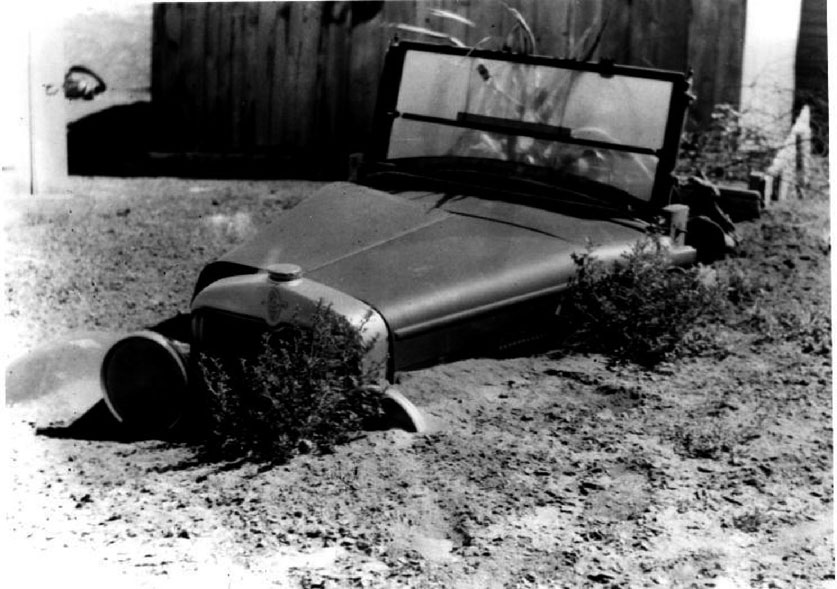
....
As dust constantly blows against something it will slowly erode it, penetrate it, and saturate it. The woman from Garden City says the dust dirties her face and is ground in between her teeth. Her health and therefore her physical body are threatened. Cars that get dust in their engines, animals that are left outside during a dust storm, and houses which become unlivable and no longer ‘homes’ are all examples of such a dematerialization, even when the dust storms end.
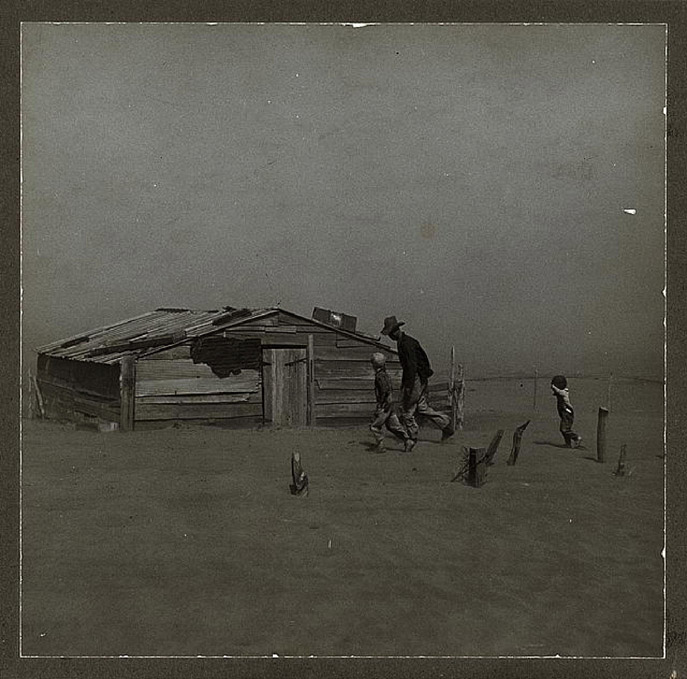
....
Additionally, the fate of those living in the Dust Bowl seemed to be “…immediately tied to the land” (Wooster 166), and the land seemed to be attacking them. A man in the Dust Bowl commented, “…there seems no chance to escape the irritation of the prickly chaff and dust which surrounded us in a moving cloud and adhered to our clothing and sweet – damp skin” (Henderson 98). Landscape implies that which are a part of it, namely, humans, environments and things. “Thus the properties of materials, regarded as constitutes of an environment, cannot be identified as fixed, essential attributes of things, but are rather processual and relational” (Ingold 14). They occur rather than exist; they are experienced rather than determined. The description of properties of materials tells a story of what has happened to them within the oceans of materials as they flow, mix and mutate. And we must read the experiences of the Dust Bowl, not as a strictly man-made phenomena or as nature attacking the human cultivated land. Rather, it is an interaction between the two, both having equal roles to play. If we keep the subject/object dichotomy, “…it seems we have human minds on the one hand and a material world of landscapes and artifacts on the other” (Ingold 3). During dust storms, dust was subsumed in the air, sometimes invisible, and was also part of the landscape when it re-settled. But it was also breathed in by humans and caused serious sickness and even death. If dust can penetrate the human body and cause it to cease to exist, then there really is not a boundary between the materiality of dust and the materiality of the human body.
In a letter written by Caroline Henderson, she describes how the boundary of their homestead in the Dust Bowl is marked by a cornerstone and what happened when the cornerstone was removed:
“A short time ago a big tractor accidentally hooked on the cornerstone of the original survey and dragged it off up the road. All these many years that stone has marked the corner of our homestead…(and has) suggested the preparation for human occupation – the little homes that were so hopefully established here, of which so very few remain. And now the stone is gone and the manner of its removal seemed almost symbolic of the changes that appear inevitable” (Henderson 151).
The changes are marked in the land, whether by humans moving a stone or dust eroding and re-settling. The dust did not recognize boundaries and blew indistinctly across property. With no crops to plant or to harvest due to dust storms the significance of her cornerstone as a marker is undermined as a result of the un-arable land. The stone, as we have learned, is not just a stone. Rather its presence indicates the history of the inhabitants of the property it marked, as does its absence. Similarly, the dust that lingers after a storm, the dust that must be cleaned, swept away, coughed out of lungs even, also constructs the history of the Dust Bowl, equally as much as the so-called human agents who lived it.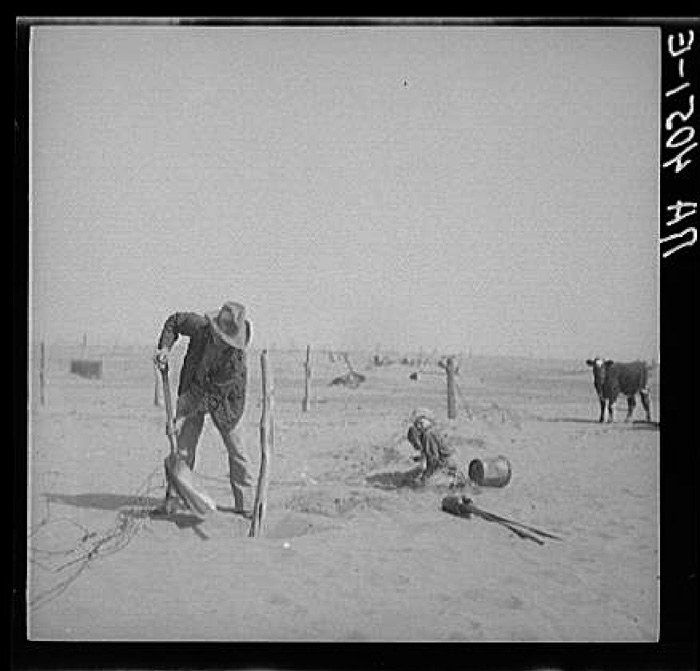
.....
When grouped together the dust particles really are the dirt and soil of the landscape which the Dust Bowl inhabitants made their living. The gathering and subsequent re-settling of land and air in the dust storms is not just a material interaction, but also has implications for those who lived there. Indeed, social relationships are similarly and necessarily gathered and re-settled. Bjornar Olsen writes, “Things, objects, landscapes, possess ‘real’ qualities that affect and shape both our perceptions of them and our cohabitation with them” (Olsen 88). Olsen means the human body is not simply the “flesh of the world” and that the world is held together solely by human cognition. He continues, “…when we encounter burials, figurines and landscapes…what we are confronted with are really nothing but ourselves and our social relations” (Olsen 94). Even the landscape of the Dust Bowl is not just a material that humans act on but is also a part of Ingold’s ocean of materials that reflect and are reflective of us.
Furthermore, “The falseness (of subjecthood in objects) seems to arise when we transgress a certain border, between the ‘us’ and the ‘it’, projecting relations prescribed for one realm onto another” (Olsen 95). This border, however, only exists when a subject is defined as opposed to an object. In other words, the one necessarily distinguishes the other. Recognizing the border as a construction helps to question its validity. By organizing the space of the Dust Bowl as a community around the phenomena of dust accumulation, a common experience was articulated and in the action of naming the Dust Bowl a community was formed. The name becomes captured in social discourses as a mnemonic and helps construct landscapes and identities of those who inhabit that space.
Identity and community formation are also tied to our experiences and how we are situated in the “ocean of materials”. When this situation shifts then we necessarily change with it. “Merleau-Ponty claims that prior to the Cartesian ‘I think’ it is necessary to acknowledge an ‘I can’ or ‘I do’; that is: a practical, non-discursive consciousness which governs my relationship with the world and which is expressed in routinized practices and actions in bodily habits” (Olsen 96). Knowledge comes from practice, our habits in the world of materials, our being in the world.
Pierre Bourdieu writes, “…the structures characterizing a determinate class of conditions of existence produce the structures of the habitus, which in their turn are the basis of the perception and appreciation of all subsequent experiences” (Bourdieu 54). Habitus is of history and determines a history. The experience of the Dust Bowl was tempered by the previous experience with dust, how a particular individual was situated in a world of materials. And with increased dust accumulation, the old habits of cleaning took on a greater significance. One woman said, “It seemed useless: the repetitive tasks of cleaning a surface or a curtain or a floor that would sprout a new growth of prairie whiskers within half a day” (Egan 234). There are accounts after accounts of people going through the motions of clearing their house of dust again and again. For instance, Caroline Henderson writes to a friend:
“After one such storm, I scraped up a dustpanful of this pulverized soil in the first preliminary cleaning of the bathtub. It is a daily task to unload the leaves of the geraniums and other house plants, borne down by the weight of the dust settled upon them, and to excavate the crocuses and violets and other little growing things that we have cherished out of doors. A friend writes of attending a dinner where ‘the guests were given wet towels to spread over their faces so they could breathe’. At the little country store of our neighborhood after one of the worst of these storms, the candies in the show case all looked alike and equally brown…’Dust to eat,’ and dust to breathe and dust to drink. Dust in the beds and in the flour bin, on dishes and walls and windows, in hair and eyes and ears and teeth and throats, to say nothing of the heaped up accumulation of floors and window sills after one of the bad days” (Henderson 141).
The past becomes present and perpetuates itself. “The habitus makes questions of intention superfluous, not only in the production, but also in the deciphering of practices and works” (Bourdieu 58), because it is habit that drives intention and action. Our past experience with materials is constantly determining new experiences. The house has to be cleaned of dust so the social life of the Dust Bowl becomes, in part, that of perpetual housework. Moreover, the Dust Bowl experience cannot be fully appreciated without these understandings.
To conclude, I would like to refer to Merleau-Ponty. He writes, because we have an experience of the real as imagining, the problem is, “…making explicit our primordial knowledge of the real, of describing our perception of the world as that upon which our idea of truth is forever based” (Merleau-Ponty xviii). There is a pre-existing mental image and then a corresponding material thing. But the mental image is constructed through our experiences with things and always in relation to those things. So we should not ask if we perceive the world, rather, we can see that the world is what we perceive, a world of materials. Perception is the access to a person’s idea of truth. “The phenomenological world is not the bringing to explicit expression of a pre-existing being, but the laying down of being” (Merleau-Ponty xxii). Truth is brought into being, the world is brought into being, through our perception of it. So the world of the Dust Bowl was determined by those who lived it but also by the world of materials and the relationships with those materials that were already there. In turn, through these reworked experiences, it lives on through our perceptions of it.
Tim Ingold reminds us that “The properties of materials…are not attributes, but histories” (Ingold 15). We cannot, for instance, understand dust outside of its involvement with its surroundings. Likewise, the experience of the Dust Bowl cannot be fully understood without a look at the relationship with dust, not as an object, but as part of the world that the people living in the plains in the 1930’s were mixed up in. Looking at dust in a relationship with people, then, helps us to see that phenomena, such as the Dust bowl, cannot be merely explained as a case of nature acting against humans or humans controlling nature. Humans are not just agents, acting in an inert landscape assailed by the forces of nature. Rather, dust and humans inhabit a world of materials in constant flux, where changes occur when relations are transformed.
works cited
Bourdieu, Pierre. The Logic of Practice. Stanford: Stanford University Press, 1992.
Brown, Bill. “Thing Theory” Critical Inquiry, no. 1 (Autumn 2001): 1-22
Cosgrove, Denis. Social Formation and Symbolic Landscape. London: Croom Helm, 1984.
Egan, Timothy. The Worst Hard Time: The Untold Story of Those Who Survived the Great American Dust Bowl. New York: Mariner Books, 2006.
Henderson, Caroline. Letters from the Dust Bowl. Norman: University of Oklahoma Press, 2001.
Ingold, Tim. “Materials Against Materiality” Archeological Dialogues, no. 14 (2007): 1- 16.
––––––. “Writing Texts, Reading Materials: A Response to My Critics” Archaeological Dialogues, no. 14 (2007): 31-38.
Merleau-Ponty, Maurice. Phenomenology of Perception. New York: Routledge, 2002.
Olsen, Bjornar. “Material Culture After Text: Re-membering Things” Norwegian Archeological Review, no. 3 (2003): 87-104.
Wooster, Donald. Dust Bowl: The Southern Plains in the 1930's. New York: Oxford University Press, 1979.